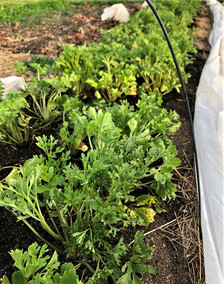January 2020
- Rosa
- Jan 31, 2020
- 2 min read
The New Year

The first month of the new year passed quickly. Concetta, Lilly, and I worked hard to complete all of our winter tasks. Spring comes early to farms, and by February we'll be inundated with needy young plants.
The weather was remarkably fair, so we could spend entire days outside. The sun arrived late and departed early, but occasionally saturated the sky with color before it went.
The hardy annual flowers which we planted in fall (and winter) grow on with peaceable determination. The Queen Anne's Laces send frequent lime-greens leaves up from the center of their whorls.
The Ranunculus are outpacing the other flowers, and one even offered a single bloom. It lingered for several days, pink peaking from the sepals, before a hard frost disintegrated its delicate petals.
Wintertime Chickens
The chickens don't exactly love the cold, though they may prefer it to the sweltering heart of summer. In icy early mornings, Concetta refills their frozen waters and treats them to protein-rich grubs. She collects their eggs then and again in the evening. On top of water, feed, treats, and hay, chickens need attention. Many of our young Rhode Island Reds rush up to the gate when she arrives and beg to be pet. They all follow her around the pasture, wherever she goes.
We moved their coops out from under the trees, giving them new pastures in the field. The move went smoothly until the end, when our bantam hen Diana refused to leave the familiar shelter of her tree. I won't say how long the tiny chicken evaded capture, since it was 3 to 1 and I'd like to retain a bit of dignity.
The chickens that properly moved to their new homes immediately targeted the young sprouts of vetch twining up the grass. In the winter, the chickens take a fierce liking to fresh greens. Since they're now next to the field garden, we drop in succulent weeds and arugula leaves whenever we're out working.
Bed Building and Cover Cropping
The majority of January was spent completing the groundwork for our garden- literally. We added a layer of leaf compost to every single one of our beds, and built dozens more. We now have nearly 60 beds awaiting planting.
We cover cropped a few of our beds last fall with mixed clover. It grew well, developing plumes of the familiar 3-lobed leaves, as soft as puppy ears. The clover watched over the soil throughout the frosty winter, and then the time arrived for it to be incorporated into the soil. Concetta loosened its matted roots with a broad-fork and then raked several inches of leaf compost over the entire bed. The new soil will act as mulch and compost the clover in place.
Although it is not in the legume family, clover is capable of fixing nitrogen and is thus an excellent cover crop. Our soil was young, so there might not have been much of the bacterial partners that the clovers needs to transform atmospheric nitrogen. Nonetheless, the carbon and nutrients it did accumulate will feed the soil and benefit a crop of eucalyptus in the spring.





























Comments